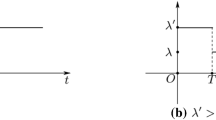Abstract
This paper concerns the joint replenishment problem for a single buyer who sells multiple types of items to end customers. The buyer periodically replenishes the item inventory to order-up-to levels to cover the end customers’ demands, which may be non-stationary. A joint replenishment policy characterized by a variable order-up-to level is proposed for buyers who wish to minimize the expected cost of operating the inventory system. According to the proposed policy, each period starts with calculation of the expected cost of two options, ordering and not ordering each item, based on a current inventory position and forecasted demand for the upcoming period. The proposed policy then uses an integer-programming model to generate a cost-minimizing decision for the joint replenishment. A computer experiment was performed to test the efficiency of the proposed policy. When compared with the most efficient policy currently available, our policy yielded considerable cost savings, especially for non-stationary demands.









Similar content being viewed by others
References
Atkins D, Iyogun PO (1988) Periodic versus ‘can-order’ policies for coordinated multi-item inventory systems. Manag Sci 34:791–796
Balintfy JL (1964) On a basic class of multi-item inventory problems. Manag Sci 10:287–297
Braglia M, Castellano D, Frosolini M (2016a) Joint-replenishment problem under stochastic demands with backorders-lost sales mixtures, controllable lead times, and investment to reduce the major ordering cost. J Oper Res Soc 67(8):1108–1120
Braglia M, Castellano D, Gallo M (2016b) An extension of the stochastic Joint-Replenishment Problem under the class of cyclic policies. Oper Res Let 44(2):278–284
Braglia M, Castellano D, Song D (2017) Distribution-free approach for stochastic Joint-Replenishment Problem with backorders-lost sales mixtures, and controllable major ordering cost and lead times. Comput Oper Res 79:161–173
Dixon PS, Silver EA (1981) A heuristic solution procedure for the multi-item, single-level, limited capacity, lot-sizing problem. J Oper Manag 2:23–39
Dodin B, Elhafsi M (2004) Production planning of a multi-item-single-facility system with non-stationary demands. Int J Oper Quant Manag 12:1–22
Eynan A, Kropp DH (2007) Effective and simple EOQ-like solutions for stochastic demand periodic review systems. Eur J Oper Res 180:1135–1143
Federgruen A, Groenevelt H, Tijms HC (1984) Coordinated replenishments in a multi-item inventory system with compound poisson demands. Manag Sci 30:344–357
Fogarty D, Barringer R (1987) Joint order release decisions under dependent demand. Prod Invent Manag J 28:55–61
Fung R, Ma X (2001) A new method for joint replenishment problems. J Oper Res Soc 52:358–362
Goyal SK (1974) Determination of optimum packaging frequency of items jointly replenished. Manag Sci 21:436–443
Goyal SK, Belton AS (1979) On a simple method of determining order quantities in joint replenishments under deterministic demand. Manag Sci 25:604
Ho WT (2013) Determining the optimum ordering policy in multi-item joint replenishment problem using a novel method. Math Probl Eng 2013:9
Jackson P, Maxwell W, Muckstadt J (1985) The joint replenishment problem with a powers-of-two restriction. IIE Trans 17:25–32
Johansen SG, Melchiors P (2003) Can-order policy for the periodic-review joint replenishment problem. J Oper Res Soc 54:283–290
Joneja D (1987) Multi-echelon and joint replenishment production and distribution systems with non-stationary demands. Technical Report No. 731, School of Operations Research and Industrial Engineering, 14 College of Engineering Cornell University, Ithaca
Kaspi M, Rosenblatt MJ (1983) An improvement of silver’s algorithm for the joint replenishment problem. IIE Trans 15:264–269
Khouja M, Park S, Saydam C (2005) Joint replenishment problem under continuous unit cost change. Int J Prod Res 43:311–326
Konur D, Schaefer B (2016) Economic and environmental comparison of grouping strategies in coordinated multi-item inventory systems. J Oper Res Soc 67(3):421–436
Larsen C (2009) The Q(s, S) control policy for the joint replenishment problem extended to the case of correlation among item-demands. Int J Prod Econ 118:292–297
Lee LH, Chew EP (2005) A Dynamic joint replenishment policy with auto-correlated demand. Eur Oper Res 165:729–747
Lee FC, Yao MJ (2003) A global optimum search algorithm for the joint replenishment problem under power-of-two policy. Comput Oper Res 30:1319–1333
Martel A, Diaby M, Boctor F (1997) Multiple items procurement under stochastic nonstationary demands. Eur J Oper Res 87:74–92
Melchiors P (2002) Calculating can-order policies for the joint replenishment problem by the compensation approach. Eur J Oper Res 141:587–595
Mohammaditabar D, Ghodsypour SH (2016) A supplier-selection model with classification and joint replenishment of inventory items. Int J Syst Sci 47(8):1745–1754
Montgomery DC, Johnson LA, Gardiner JS (1990) Forecasting and time series analysis, 2nd edn. McGraw-Hill, Singapore
Nielsen C, Larsen C (2005) An analytical study of the Q(s, S) policy applied to the joint replenishment problem. Eur J Oper Res 163:721–732
Nilsson A, Segerstedt A, Sluis E (2007) A new iterative heuristic to solve the joint replenishment problem using a spreadsheet technique. Int J Prod Econ 108:399–405
Ohno K, Ishigaki T (2001) A multi-item continuous review inventory system with compound poisson demand. Math Methods Oper Res 53:147–165
Porras E, Dekker R (2008) A solution method for the joint replenishment problem with correction factor. Int J Prod Econ 113:834–851
Rosenblatt MJ, Lee HL (1986) Economic production cycles with imperfect production processes. IIE Trans 18:48–54
Seth D, Pandey MK (2009) A multiple-item inventory model for a non-stationary demand. Prod Plan Control 20:242–253
Silver EA (1976) A simple method of determining order quantities in joint replenishments under deterministic demand. Manag Sci 22:1351–1361
Viswanathan S (1997) Periodic review (s, S) policies for joint replenishment inventory systems. Manag Sci 43:1447–1454
Viswanathan S (2002) On optimal algorithms for the joint replenishment problem. J Oper Res Soc 53:1286–1290
Zheng YS, Federgruen A (1991) Finding optimal (s, S) policies is as simple as evaluation a single policy. Oper Res 39:654–665
Acknowledgements
This work was supported by the research fund of Hanyang university (HY-2017-G).
Author information
Authors and Affiliations
Corresponding author
Rights and permissions
About this article
Cite this article
Yang, Y.H., Kim, J.S. An adaptive joint replenishment policy for items with non-stationary demands. Oper Res Int J 20, 1665–1684 (2020). https://doi.org/10.1007/s12351-018-0399-9
Received:
Revised:
Accepted:
Published:
Issue Date:
DOI: https://doi.org/10.1007/s12351-018-0399-9




